Hitch height
30 posts
• Page 2 of 2 • 1, 2
I was following a couple good old boys with 5 38" - 42" in in diameter logs about 20' long on a tandem axle trailer. Halfway down a 35 degree grade was a road to the right. The good old boys wanted to turn and did
( more or less) The trailer picked the truck up by the ball and deposited the driver side rear tire dead center in the middle of the hood of a pristene thunderbird with a very hysterical woman screaming at the top of her lungs. Boys that's 3 1/2 ' into the air. They will lift under braking I saw it !!
( more or less) The trailer picked the truck up by the ball and deposited the driver side rear tire dead center in the middle of the hood of a pristene thunderbird with a very hysterical woman screaming at the top of her lungs. Boys that's 3 1/2 ' into the air. They will lift under braking I saw it !!
Growing older but not up !
-

bobhenry - Ten Grand Club

- Posts: 10368
- Images: 2623
- Joined: Fri Feb 09, 2007 7:49 am
- Location: INDIANA, LINDEN
bobhenry wrote:I was following a couple good old boys with 5 38" - 42" in in diameter logs about 20' long on a tandem axle trailer. Halfway down a 35 degree grade was a road to the right. The good old boys wanted to turn and did
( more or less) The trailer picked the truck up by the ball and deposited the driver side rear tire dead center in the middle of the hood of a pristene thunderbird with a very hysterical woman screaming at the top of her lungs. Boys that's 3 1/2 ' into the air. They will lift under braking I saw it !!
Yep, trailer brakes are worth their weight in gold when you need them.
Just like a gun, better to have one and not need it, than to need one and not have it.

~ Mark
- Mark Freedom
- Teardrop Advisor
- Posts: 71
- Joined: Fri Jun 06, 2008 10:25 am
- Location: Idaho






